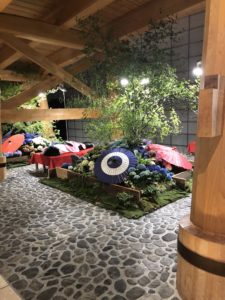In order to find out how local Japanese people view the US, I interviewed the two members of my host family and a teacher from the kindergarten my host mom works at.
When asked what the first thing to pop into their minds about the US was, two out of the three said the Statue of Liberty. They also mentioned other famous landmarks, such as the Grand Canyon and Niagara Falls. When asked hw they felt about the US, mostly I got very positive responses. They said things like they love or like the US, and that it seems very “cool” to them. They also said it was somewhere they would like to travel. One person also said that when they think about the US, they think of how much larger it is than Japan, and also that they are jealous that the houses are much larger in Japan.
When they were asked about possible things they disliked about the US, biggest answer I received was about the fact that people are allowed to carry guns in the US. My host family expressed the sentiment that they thought this is a dangerous practice, and wished that it was different. Someone also said they thought the portion sizes in the US were extremely large, and that when they are in the US they can ever finish their meals.
We started talking about some of the cultural differences between Japan and the US, and something that my host family said they really like about the US is that there is equality between men and women. They said that in Japanese culture, women and men still are considered quite equal, and they like the fact that men and women are seen in the same light in the US. Another cultural difference mentioned in one interview was that they think Americans are open-minded. They said that because the US is so big and has so many different kinds of people, the people there are much more open-minded and willing to accept people who are different. One person said that Americans are less judgmental due to the openness in the US.
Finally, the both teachers said that they liked the American education system better than the Japanese one. One of them said it is due the fact that it is more varied and less rigid than the Japanese system. One said it is more open to individualism, which is something they appreciate.
Overall, the interviews were really interesting for seeing how people from a different country view the US and US citizens. It was fun to do, and afterwards we switched and they wanted to know what I thought about Japanese culture and its quirks. I really enjoyed all the conversations we had and it was an interesting opportunity for cultural exchange.





 were all given passes to the nearby traditional onset for baths for the night. It was a really interesting experience and definitely very different from anything back in the US, but I can say that I would gladly go again because it was also extremely relaxing. In the onset there was also even a restaurant, where we were able to get our first meal in Hakodate outside of the hostel!
were all given passes to the nearby traditional onset for baths for the night. It was a really interesting experience and definitely very different from anything back in the US, but I can say that I would gladly go again because it was also extremely relaxing. In the onset there was also even a restaurant, where we were able to get our first meal in Hakodate outside of the hostel! Along those lines, I tried kendo and kyudo last week! Kyudo was really hard because the arrows just kind of went into the grass. I only hit one target (and it was the wrong one three targets over) but it was awesome to watch the high school kids do it really well. Kendo was super fun because I got to wear a cool outfit (pictured!), yell, and swing a wooden sword around. It was kinda scary at first because we were just hitting the sensei in the head repeatedly, which was mildly worrisome, but after we all adjusted it was pretty great.
Along those lines, I tried kendo and kyudo last week! Kyudo was really hard because the arrows just kind of went into the grass. I only hit one target (and it was the wrong one three targets over) but it was awesome to watch the high school kids do it really well. Kendo was super fun because I got to wear a cool outfit (pictured!), yell, and swing a wooden sword around. It was kinda scary at first because we were just hitting the sensei in the head repeatedly, which was mildly worrisome, but after we all adjusted it was pretty great.



